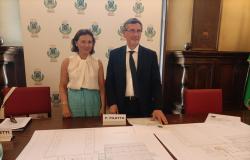Fondazione Brescia Musei is pleased to present two new publications published by Skira dedicated to the Castle of Brescia and its Museums: The history of the Castle of Brescia from the Middle Ages to the nineteenth centuryedited by Marco Merlo and Sara Scalia (2023) e Tito Speri. History and objects of a conspirator of the Risorgimento by Enrico Valseriati (2024).
The history of the Castle of Brescia from the Middle Ages to the nineteenth century is the conclusion of a multi-year research path that has seen the Brescia Musei Foundation and the Culture and Civilization Department of the University of Verona involved side by side: a project resulting from the collaboration that the two institutions signed in 2020 and which allows to fulfill one of the mandates that the Brescia Museums Foundation has received from the Municipality, namely that of enhancing the city’s heritage through study, the promotion of knowledge and its dissemination. One of the guidelines immediately identified for this collaboration was the history of the Castle of Brescia, a central place for the definition of the historical and cultural identity of Brescia.
The volume presents an original research method based on the intersection between historical investigation and systematic analysis of cartographic documentation which allows us to tackle in an unprecedented way the study of the Castle of Brescia, a complex monument in which the building phases have been stratified over the centuries, marking the main events of the City, focusing above all on the medieval and modern ages, starting from the age of the free Municipality to the Unification of Italy: centuries in which access to the fortress was barred to most people, thus greatly reducing the possibility of collecting and record testimonies.
With its 75,000 square metres, the Brescia fortress is one of the largest in Europe: a unique construction, in which, around the Visconti-era keep, a modern system of walls and bastions developed which made it one of the most impressive defensive structures of the Venetian mainland. The written and iconographic sources, placed in dialogue with the ancient maps, in turn reread and reinterpreted with the aid of digital technology, return a precise philological reconstruction, rich in photographic documentation and capable of highlighting some unpublished or little-known aspects of a fascinating and extraordinarily complex story.
Tito Speri. History and objects of a conspirator of the Risorgimento by Enrico Valseriati (2024) is the first monographic work promoted by the Brescia Musei Foundation within the broader reopening project of the Risorgimento Museum Lioness of Italywhich took place in January 2023.
The relevance of the Risorgimento Museum (and of the work on Speri which is presented in the volume) also has important repercussions on the places and cultural assets that the Foundation and the Municipality manage together. Among all, the Castle of Brescia certainly stands out, in which both the Risorgimento Museum and the “Luigi Marzoli” Weapons Museum are located. And it is precisely from the Castle that an ideal itinerary on the Brescia Risorgimento – and therefore on Tito Speri himself – can be unravelled, as the visit tools designed by the Brescia Musei Foundation also invite you to do, including the walking tour “The Ten Days. From the barricades to memory”, launched on the occasion of the opening of the Leonessa d’Italia on our applications.
The preparatory work for the rebirth of the Risorgimento Museum in Brescia involved an in-depth study of the entire Risorgimento collection preserved in the deposits of the Civic Museums of Art and History, managed by the Brescia Museums Foundation. In this multitude of finds and documents, Tito Speri occupies a space
important, as is demonstrated by the high number of objects referable to him and which are accounted for in the appendix to this book. The gun of the ‘lion of Brescia’, his gloves, his watch, his slippers, his handwriting, his relics handed over to posterity from the prisons of Mantua, every object, every portrait, every heirloom has its own peculiar history, which it was necessary to analyze not only from a material point of view, but also through a deep archival excavation.
The study of the construction of the memory of Speri, one of the most famous patriots of the Risorgimento (Brescia, 2 August 1825 – Mantua, 3 March 1853), did not have as its objective the ‘simple’ reconstruction of a personal and historical profile: the aim, rather, it was both to analyze individual objects – some more, some less speaking in themselves – and to articulate a material biography which is the result of the dialogue between the objects themselves, the documentary sources, the iconographic representations of Tito and the historiographical insights on him. he.
But above all it wanted to retrace the memory of the Brescian hero in public space, as well as the ‘fortune’ of the objects that belonged to him and the iconography dedicated to him from the second half of the nineteenth century to the present day.






